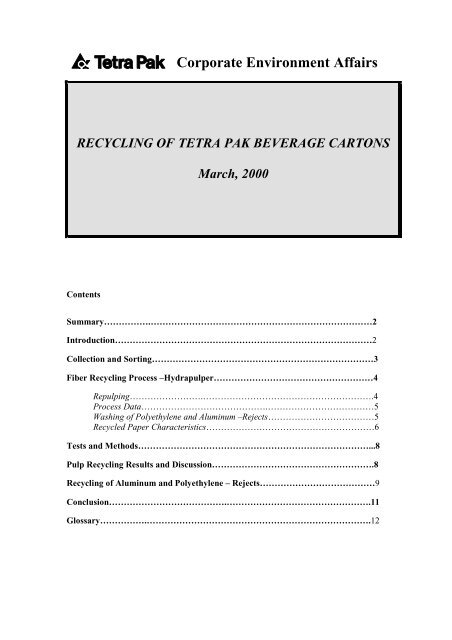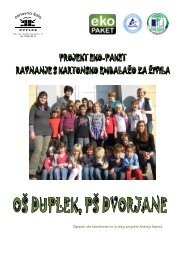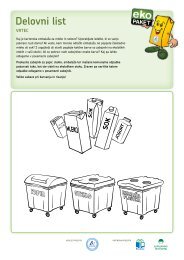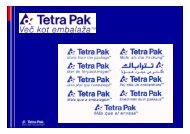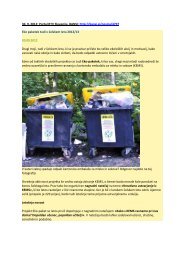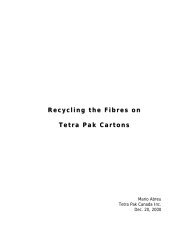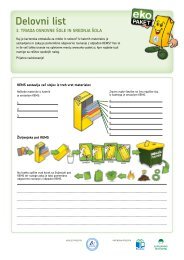Corporate Environment Affairs RECYCLING OF TETRA ... - Eko paket
Corporate Environment Affairs RECYCLING OF TETRA ... - Eko paket
Corporate Environment Affairs RECYCLING OF TETRA ... - Eko paket
You also want an ePaper? Increase the reach of your titles
YUMPU automatically turns print PDFs into web optimized ePapers that Google loves.
<strong>Corporate</strong> <strong>Environment</strong> <strong>Affairs</strong><br />
<strong>RECYCLING</strong> <strong>OF</strong> <strong>TETRA</strong> PAK BEVERAGE CARTONS<br />
Contents<br />
March, 2000<br />
Summary…………….…………………………………………………………………2<br />
Introduction……………………………………………………………………………2<br />
Collection and Sorting…………………………………………………………………3<br />
Fiber Recycling Process –Hydrapulper………………………………………………4<br />
Repulping…………………….………………………………………………….4<br />
Process Data…………………………………….………………………………5<br />
Washing of Polyethylene and Aluminum –Rejects………………………………5<br />
Recycled Paper Characteristics…………………………………………………6<br />
Tests and Methods……………………………………………………………………...8<br />
Pulp Recycling Results and Discussion……………………………………………….8<br />
Recycling of Aluminum and Polyethylene – Rejects…………………………………9<br />
Conclusion………………………………….………………………………………….11<br />
Glossary…………….………………………………………………………………….12
SUMMARY<br />
This paper is based on many experimental trials at paper mills and shows the basic process to<br />
recycle Tetra Pak post consumer cartons, from collection and sorting programs, on industrial level.<br />
The mechanical characteristics showed excellent fibers for using in a number of papermaking<br />
processes. Paper represents 75 % of the package, polyethylene 20 % and aluminum 5 %. The<br />
repulping process takes about 35 minutes and separates pulp from aluminum and polyethylene<br />
layers. Aluminum and polyethylene discharged after the repulping process can also be recovered in<br />
three ways: burning to generate energy, Aluminum recuperation by pyrolysis or plasma kiln and<br />
manufacturing of plastic products trays with thermo injection processes. For each ton of packaging<br />
added to the system at least 650 Kg of good quality fiber can be recovered.<br />
1.0 – INTRODUCTION<br />
The utilization of recycled fibers from used cartons has grown substantially. While economic<br />
factors are not always controllable and still a great concern, environmental demands for the use<br />
of secondary fibers in the paper industry have increased. This subject has been the object of<br />
several scientific papers, attempting to show the gains from the utilization of this kind of fiber. In<br />
some countries, Belgium for instance, there is legislation, which requires the use of secondary<br />
fibers in the composition of paper. Some countries have set the goal to include recycled fibers in<br />
all printing paper sold.<br />
The greatest gain in U.S. paper recycling for instance, was achieved in the corrugated board<br />
sector, with an increase in annual growth to more than 11 million tons in less than eight years.<br />
Within this segment, recycled corrugated board was the most successful venture. By the end of<br />
the year 2000, the forecasted annual capacity for this segment will exceed 8.3 million tons, a<br />
growth rate of 70 percent in the ‘90s.<br />
Both recycled linerboard and corrugated medium (internal layer of the corrugated board) share<br />
this rapid growth, a phenomenon based on the economic value of the recovered fiber. For<br />
example, the increase in old corrugated container (OCC) consumption is influenced by the lower<br />
capital cost of developing OCC recycling capacity versus the capital cost for virgin pulping<br />
facilities. Also , recycled board mills often are located in close proximity to sources of recovered<br />
materials and the targeted customers for the finished containers.<br />
Tetra Brik Aseptic cartons, utilized in the aseptic filling of UHT processed products, are made up<br />
of three raw materials: paper (Duplex, CTMP or Bleached), low density polyethylene and<br />
aluminum foil. Tetra Brik Aseptic packaging (TBA) is composed of six layers starting from inside<br />
out: polyethylene, polyethylene, aluminum, polyethylene, paper and polyethylene. The internal<br />
polyethylene layers have the function of making the packaging impermeable and preventing food<br />
contact with the aluminum. The aluminum layer prevents the penetration of air and light thus<br />
assuring the preservation of food contents. Paper provides stiffness. The package is composed of<br />
75% paper (long fiber), 20% polyethylene and 5% aluminum.<br />
Tetra Brik packages (TB) are used for chilled products and are made of paper (Duplex or CTMP)<br />
and low density polyethylene.<br />
Tetra Rex packaging is composed of bleached paper and polyethylene. A layer of aluminum may<br />
also be present in its composition. This packages material is used for pasteurized liquid food<br />
such as juices and milk.<br />
2
Tetra Top packaging material is composed by duplex paper and low-density polyethylene and is<br />
also used for pasteurized products.<br />
Recycling of cartons is initially done at paper mills, which use its fibers in the manufacturing of<br />
several types of papers. Recovery of polyethylene and aluminum can be accomplished in three<br />
different ways: energy recovery through burning in cement kilns or incinerator thus saving fuels;<br />
aluminum recovery by pyrolysis or plasma furnace; or in the manufacture of plastic objects by<br />
extrusion or injection/molding processes.<br />
2.0 COLLECTION and SORTING<br />
The collection and sorting operations are an important part in the recycling system of cartons.<br />
There is a tendency to establish collection by legislation as a way of solving the Municipal Solid<br />
Waste problem. According to a World Bank book “ Solid Waste Landfills in Middle- and Lower-<br />
Income Countries” , edited in l999, 76% of all solid waste collected in the developing countries is<br />
disposed of in inadequate places (open dumps), 13% in managed landfills, 10% in waste landfills,<br />
and only 1% is treated (composting, recycling and incineration).<br />
Fig. 1 - Carton Sorting – Europe Fig. 2 - Carton Sorting<br />
Fig. 3 - Carton Bales Fig. 4 - PET Bottles Sorting<br />
The main collection schemes for Tetra Pak cartons are “Drop Off” system with other light<br />
packaging or collection together with the paper stream (the cheapest solution) or “Curb Side<br />
3
Collection” where the “dry material” is collected directly in the households, as curb side collection<br />
of cartons and other paper packages.<br />
3.0 FIBER <strong>RECYCLING</strong> PROCESS - HYDRAPULPER<br />
3.1 REPULPING<br />
In order to recover the fiber from the packaging material, the various layers of materials, which<br />
make up the package, must be separated. The separation of the materials is done in a high,<br />
medium, or low consistency hydrapulper (big blender) with a volume from 5.000 to 40.000 liters.<br />
A process time settling period of 30 to 40 minutes is necessary so that the fiber present in the<br />
packages can be separated and remain in suspension allowing its removal by pumping action.<br />
The separation process of this type of material does not require the utilization of any chemical<br />
additive or hot water. The packaging is mixed with water in a concentration range from 3% (30 Kg<br />
of packaging in 970 Kg of water) up to 15% (150 Kg of packaging in 850 Kg of water) by weight,<br />
agitated during 30 to 40 minutes. Almost all fibers present in the carton will be separated from the<br />
plastic/aluminum layers<br />
Tetra Pak factory waste - laminated material – in general, must be shredded (20X10cm pieces)<br />
before sending to the paper mill to be recycled. Shredding is necessary to improve repulping time<br />
and also to facilitate discharge of the rejects (plastic/aluminum) from the hydrapulper.<br />
Post consumer cartons do not need to be shredded before entering the pulper, except when<br />
using a “Rotary Drum” pulper. In that case a cutting device is installed in the feeding conveyer<br />
just before the pulper.<br />
Tetra Pak’s carton fibers are utilized in the production of several types of products such as<br />
corrugated board, cardboard, egg cartons, inner soles, tissue paper, paper core, etc.<br />
Rotor and speed used in the pulper will determine some of the characteristics of the recovered<br />
fiber. Low-consistency rotors (fig. 5) are used when a fast pulping is desired and cut fibers are<br />
tolerated. High-consistency rotors (fig. 6) promote a high shear action among fibers and a smooth<br />
pulping, but in a longer time than before. Medium-consistency rotors are seldom used as a<br />
compromise solution between low and high consistencies. Speeds are directly linked to energy<br />
consumption and both are usually optimized for best results in every application. Consistency is<br />
mentioned on a percent basis of the amounts of fibers diluted per water volume. For pulping<br />
purposes, low-consistencies are lower than 6%, medium-consistencies between 8 and 10%, highconsistencies<br />
are from 12 to 15%.<br />
4
3.2 PROCESS DATA<br />
Fig. 5 – Low consistency rotor<br />
Fig. 6 - High consistency rotor<br />
In tests conducted at paper mills, rotations from 280 to 450 rpm have been used in the<br />
hydrapulpers. Hydrapulper mass filtering screens varied from 4 to 12 mm. Low consistency<br />
processes have the advantage of making easier the discharge of the fibrous material. Processes<br />
with high consistency require the reduction of the consistency by diluting with water before<br />
sending the fibers to the storage tank.<br />
Cartons can be recycled alone in the hydrapulper or mixed with others fibers sources like Old<br />
Corrugated Container (OCC), Mixed Office Waste (MOW) or Old Magazines (OMG). The<br />
maximum concentrations of Tetra Pak cartons in the pulper depend on the type of equipment<br />
after the repulping process. Some recycling factories have a “rotary drum” after the pulper. With a<br />
rotary drum they can use 100% batch of cartons with no majors problems. In general,<br />
concentration up to 5% of cartons mixed with OCC (Old Corrugated Container) does not affect<br />
the recycling process in the plant.<br />
3.3 WASHING <strong>OF</strong> POLYETHYLENE AND ALUMINUM - REJECTS<br />
The first separation of the fiber from the rejects containing aluminum and polyethylene is done in<br />
the hydrapulper discharge. The fibrous material that is suspended in water is removed by<br />
pumping. During the pumping the fiber goes through a perforated plate which prevents the<br />
passage of the polyethylene and the aluminum. These materials are removed laterally by gravity<br />
and go through a washing process where the residual fibers, the polyethylene and aluminum are<br />
5
washed with water (Fig. 7). After washing the recovered fibers return to the process of paper<br />
making while the polyethylene and aluminum are pressed in a bale.<br />
The type of separator or plastic washer that has proven efficient is the rotating and nonpressurized<br />
cylindrical screen or rotary drum (Fig. 8). The recovered fibers that return to the white<br />
water system can be recovered by Thickeners or Side Hill Static screens.<br />
Fig. 7 - Rejects After Rotary Drum<br />
Fig. 8 - Rotary Drum (Trommel) for Rejects Cleaning<br />
3.4 RECYCLED PAPER CHARACTERISTICS<br />
The recycling of Tetra Pak’s cartons packaging a high consistency process was studied by<br />
Bowser (l996) where post-consumer milk and juice cartons were used. The cartons were<br />
separated in a high consistency hydrapulper for 35 minutes with helicoidal rotor and were<br />
extracted through a perforated plate with 3\8 inch holes. The plastic and aluminum were<br />
removed and put through a plastic/aluminum separator to recover remaining fibers in the material.<br />
After the contaminant removal from fibers using pressurized screens and cleaners, samples were<br />
taken for tests. The results are shown on Table l.<br />
6
TEST Units I II III IV<br />
Burst index kPa m 2 /g 3,36 3,72 3,91 4,14<br />
Tear index mNm 2 /g 12,42 12,71 11,53 11,48<br />
Tensile index Nm/g 44,18 52,75 55,22 64,59<br />
Rupture strain % 3,31 3,60 3,38 3,39<br />
CSF ml 430 397 327 257<br />
Bulk cm 3 /g 1,69 1,64 1,56 1,53<br />
TABLE 1 – Results obtained in high consistency pulper recycling 100% cartons.<br />
Wastewater<br />
Treatment<br />
Sludge<br />
Fiber Recycling Process<br />
Process Flow Scheme<br />
Water<br />
Water<br />
Water<br />
Pulper<br />
Coarse Filter<br />
Fibers<br />
Cleaner<br />
Paper<br />
Machine<br />
Paper<br />
Packaging<br />
Plastic<br />
Aluminium<br />
Water<br />
Fig. 9 - Recycling of beverage cartons (Process Flow Scheme)<br />
Fig. 10 - Paper Machine (250 ton/day)<br />
7<br />
Water<br />
Extractor<br />
Boiler<br />
Al 2 O 3<br />
Refractories<br />
)<br />
Injection/Extrusion /<br />
CO 2 /H 2 O<br />
Pyrolisis<br />
Plasma<br />
Al<br />
Plastic<br />
Objects<br />
Boiler<br />
Methane/<br />
Propane<br />
STEAM
4.0 TESTS AND METHODS<br />
Industrial tests were conducted in accordance with the production processes of several recycling<br />
plants. Bales, weighing on average 300 kg each used in the various tests, were obtained from<br />
sorting centers. The material used for tests was disintegrated in 35 minutes in low consistency<br />
hydrapulper using rotor speed between 280 and 300 rpm with consistencies between 3% to 4%.<br />
After the carton disintegration, pulp samples were collected for physical analyses. The obtained<br />
samples were refined with a laboratory Valley beater and afterwards, sheets were manufactured<br />
for the physical tests in compliance with TAPPI Test Methods.<br />
5.0 PULP <strong>RECYCLING</strong> RESULTS AND DISCUSSION<br />
Tests Units I II III IV<br />
Burst index kPa m 2 /g 0,95 2,86 3,53 4,03<br />
Tear index Nm 2 /g 11,77 14,02 12,97 12,13<br />
Tensile index Nm/g 20,34 57,45 65,91 65,51<br />
Rupture strain % 0,93 1,85 2,20 2,00<br />
Thickness mm 0,1600 0,1355 0,1330 0,1290<br />
Schopper Riegler SR 20 29 41 50<br />
Dry gramature g/m 2 60,68 57,91 65,91 65,51<br />
Dry fibers contend % 91,60 93,25 93,16 93,07<br />
Bulk cm 3 /g 2,64 2,34 2,02 1,97<br />
TABLE 2 – Results of physical tests- fibrous materials obtained in industrial tests with low<br />
Consistency hydrapulpers.<br />
During the testing, it was observed that cutting rotors caused a shredding effect on the aluminum<br />
and polyethylene that had passed through the hydrapulper screen together with the fiber, making<br />
difficult the aluminum removal. In these cases, the recommendation was either reduce rotation or<br />
change the rotor.<br />
In some cases, it was noticed that, during the disintegration, Tetra Brik Aseptic packages<br />
separated more easily than the Tetra Rex packages. This is explained by the humidity resistance<br />
products (wet strength) contained in Tetra Rex packages material. In industrial terms, without<br />
use of chemical products or heating the pulper water, a the period of 35 minutes is enough to<br />
disintegrate cartons and unbind the polyethylene.<br />
The values obtained in the tests are those required by market standards for all types of paper.<br />
Part of the trials presented was carried out in plants for producing corrugated paper and the fiber<br />
tests show values that are within market requirements.<br />
8
6.0 <strong>RECYCLING</strong> <strong>OF</strong> ALUMINUM AND POLYETHYLENE - REJECTS<br />
One of the ways to recover aluminum and polyethylene, generated in the recycling process of<br />
carton packages, is incineration with energy recovery in boilers or cement kiln. This process is<br />
utilized in European countries where the material is used as fuel in cement kilns, thus reducing<br />
the use of fossil fuels. In this process the boiler or kiln should have washing gases systems or<br />
electrostatic precipitators to guarantee the retention of aluminum particles. In the combustion<br />
process the aluminum reacts with oxygen producing aluminum trioxide that can be used in the<br />
production of polyeletrolites for water treatment.<br />
One process for the recovery of aluminum is a pyrolysis furnace where a low percentage of<br />
oxygen is maintained in order to prevent the oxidation of aluminum. In this process the<br />
polyethylene reacts with the oxygen providing energy to the process. Plasma technology has<br />
been developed to recover metallic aluminum. In the Plasma process, polyethylene degrades in<br />
short molecules that can be burnt as a fuel.<br />
Processing polyethylene/aluminun in plastic recycling industries is very interesting commercially<br />
speaking. Polyethylene is a thermoplastic and can be processed over and over again. The<br />
aluminum present does not interfere in the injection or extrusion process and is incorporated in<br />
the plastic products.<br />
Aluminum and polyethylene are bound in bales, as shown in figure 11, and sent to plastic<br />
recyclers where they will undergo a new cleaning process in a washing machine for plastics<br />
that is able to remove all residual fibers from the material. After cleaning, polyethylene with<br />
aluminum is centrifuged and dried.<br />
FIG.11- Polyethylene with aluminum bale<br />
9
FIG. 12 - Rejects Cleaner<br />
The cleaning of polyethylene containing aluminum is made in an equipment (Fig. 12) fitted with a<br />
non-cutting or dull rotor (Fig. 13), operating above 1000 rpm. This allows to completely removing<br />
any trace of fibers that can harm the extrusion of the material. The separation of the fibers takes<br />
place inside the washing device by means of a perforated sieve which has two compartments. In<br />
the inner compartment, the polyethylene with aluminum is retained and in the outer compartment<br />
the paper pulp is retained. Water is injected tangentially into the walls of the washing equipment.<br />
Fig. 13 - Non-cutting or dull rotor<br />
The agglutination process consists of a thermo-mechanic treatment where a rotor agitates the dry<br />
plastic until it reaches the plastic transition temperature. The objective of this is to increase the<br />
material density, in order to make it easier to feed the extruder and remove residual moisture.<br />
Installing an exhauster where gases exit the agglutinator can optimize the moisture removal.<br />
The amount of aluminum present in the material is on average 18% to 20%. When the material<br />
goes into the agglutinator, humidity is an important factor since agglutinated material should have<br />
low humidity with the objective of eliminating possible air bubbles during extrusion. This process<br />
allows that aluminum be dispersed thus guaranteeing a homogeneous material.<br />
10
After the agglutination process, the material goes through extrusion where pellets are obtained.<br />
These pellets are the raw material for injection or lamination of plastic parts. In the extrusion<br />
process, the material is heated in an extruder (Fig. 14) and then is cut into small pellets.<br />
7.0 CONCLUSION<br />
Fig. 14 - Extrusion of Rejects (plastic/aluminium)<br />
Post-consumer cartons represent an attractive source of high quality raw material, which<br />
contributes to the improvement of the characteristics of the paper. The test results have shown<br />
that tensile index, tearing index, rupture strain, burst index and concora mediu test values are<br />
within those demanded by the market with considerable potential of gains by optimization of<br />
refining.<br />
As a commodity, the recycled paper market can easily change from US$250/ ton to US$450/ton<br />
in a period of a few months and therefore, affecting the raw material (OCC, Cartons, MOW, etc)<br />
price as well.<br />
The utilization of high consistency rotors prevent excessive cutting in the beating process and<br />
improve fiber fibrillation which represents an energy save at paper manufacture. On the other<br />
hand, most of the equipments for the production of recycled paper installed in many countries<br />
operate with low consistency hydrapulpers and low investment in production modifications is<br />
necessary in order to recycle that material. In addition is easier to discharge the pulp from low<br />
consistency hydrapulper system.<br />
The type of rotor and its rotating speed affect the final characteristics of the fiber. Cutting rotors<br />
cause the negative effect of cutting the aluminum and the polyethylene and thus contaminating<br />
the pulp and making more difficult to remove the contaminant. For processes that shred material<br />
in very fine pieces, at the point where the material goes through the hydrapulper screen, it is<br />
recommended changing the rotor or reducing the rotation.<br />
11
To summarize we can say that with minor’s investment it is possible to adapt an existing paper<br />
recycling factory to use Tetra Pak Cartons as a raw material and recovery the investment in a<br />
short period of time.<br />
Regarding the Poly/aluminum rejects the type of separator, after the pulper, that has shown the<br />
best results is the cylindrical depressurized rotating screen (Rotary Drum or Trommel). After the<br />
rejects from the separation goes through the washing in the screen mentioned above, it can be<br />
baled and sold for the recycling of plastics or incinerated in cement kilns to recovery the energy.<br />
8.0 – GLOSSARY<br />
Bleached Board - Board made with pulp that has been bleached to a high level of brightness<br />
using chemical products. Bleaching is a whitening process carried out on pulps by selective<br />
chemical removal of residual lignin and other colored materials, and with minimal degradation of<br />
the cellulosic constituents.<br />
Bulk – Volume per unit weight of paper product. Bulk is the reciprocal of apparent density.<br />
Burst index (strength) - resistance of paper to rupture under pressure, as indicated on a<br />
"Mullen" or "pop" tester.<br />
Chemical pulp - pulp obtained by cooking wood with solutions of various chemicals. The<br />
principal chemical processes are the sulfite (acid), sulfate or kraft (alkaline) and soda processes.<br />
Cleaner - Cyclone device which removes unwanted particles from fiber suspension in the paper<br />
recycling factories.<br />
Consistency – Mass Concentration – Solids Content - Mass or weight percentage of dry fiber<br />
in the hydrapulper. Consistency is often described qualitatively as low, medium or high.<br />
Corrugated Medium – Lightweight board used for the fluted inner plies (undulations) of<br />
corrugated container board, having requirements only of stiffness and runnability through the<br />
fluter.<br />
CTMP – Chemi Thermo Mechanical Pulp – A mechanical pulping process in which chips are<br />
given a chemical pretreatment whith sodium hydroxide and sodium sulphite in water. After the<br />
short chemical treatment the chips are fed into large refiners (milling machines) under pressure<br />
and defibrated at around 120 o C. Compared to chemical fibers the CTMP fibers are shorter and<br />
less flexible which results in higher stiffness. Conditions are usually controlled to produce a pulp<br />
above 90% yield.<br />
Hydrapulper – Batch or continuous equipment for dispersing waste paper or Tetra Pak cartons<br />
in water to prepare papermaking stock. It is a big blender used in recycling plants with volume<br />
from 5 m 3 up to 40 m 3 .<br />
Linerboard – Lightweight board used as the liners or facing for corrugated container. The main<br />
requirements are stiffness and strength.<br />
OCC – Old Corrugated Container – Post-consumer packaging used as raw material to recycling<br />
mills to produce corrugated board.<br />
12
Paper - a homogeneous formation of primarily cellulose fibers which are formed in water<br />
suspension on the machine wire and bound together by weaving of the fibers and by bonding<br />
agents.<br />
Plasma Kiln – Process used to separate polyethylene from aluminum foil using high temperature<br />
and in the absence of oxygen.<br />
Pressure Screen – Pulp screening equipment with some form of perforated barrier to remove<br />
oversize, troublesome and unwanted particles from good fiber.<br />
Pulp - papermaking material existing in a disintegrated fibrous wet or dry state. Before it is<br />
dispersed onto the paper machine, it is mixed, beaten, and diluted to a suitable consistency for<br />
fabrication of paper.<br />
Pyrolyses – Chemical decomposition of the polyethylene by the action of heat.<br />
Rotary Drum – Rotary Screen – Trommel – Coarse stock screen consisting of a large rotary<br />
shell fitted with perforated screen plates and having an internal spiral arrangement. It is installed<br />
in the reject exit of the pulper. Rejects enter at one end and the fiber is washed through the<br />
screen plates by high volume showers. The reject material travels to the opposite end of the<br />
cylinder (assisted by the spiral) where it is discharged. See figure 8.<br />
Stiffness – Bending resistance, a desirable property of certain paper and board grades (rigidity).<br />
Tear Index – Measure of tear strength that is independent of sheet grammage.<br />
Tensile Strength (Index) – Force required to break a narrow strip of paper when both the length<br />
of strip and rate of loading are closely specified.<br />
Wet Strength – Chemical compounds used to avoid water penetration in the paper board.<br />
White Water – General term for any stock filtrate or process water that contains fiber fines.<br />
13


